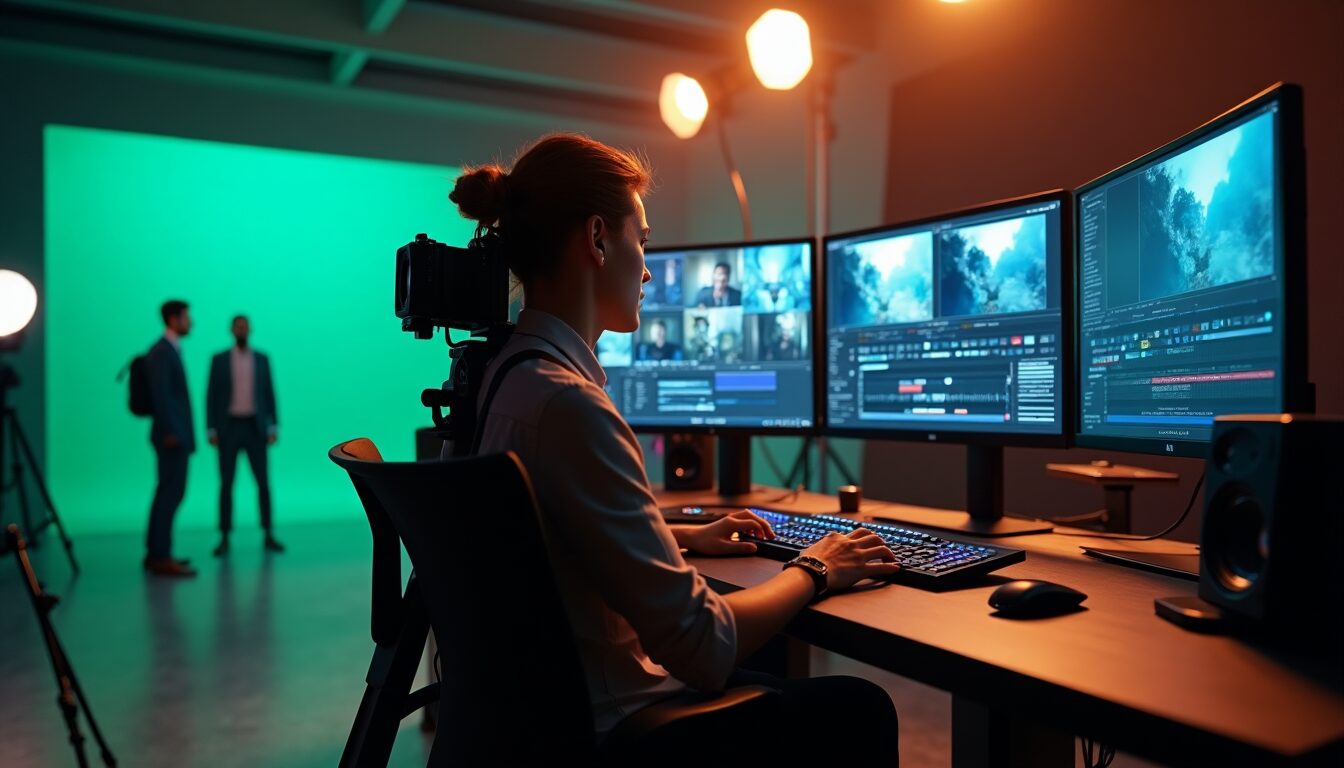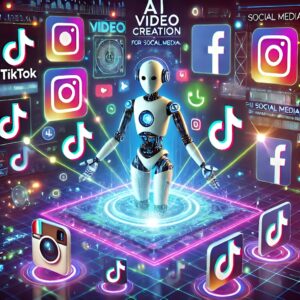Major companies like Reuters, Zoom, and Amazon are among 50,000 businesses that use generative AI video technology to create content. These AI systems now produce everything from training materials to marketing videos. The output ranges from 720p to stunning 4K resolution and supports more than 140 languages and accents, which enables truly global reach.
Video content production has transformed dramatically. OpenAI’s Sora creates videos from simple text prompts, while Runway’s Gen-3 Alpha model offers better fidelity and motion control. These tools substantially cut down production time and open new creative possibilities. Video editing has become more accessible through platforms like Descript, which enables editing through transcript changes. Wondershare Filmora adds AI features such as smart cutout and audio denoise that make professional video creation easier than ever.
This piece explores how generative AI reshapes video production. You’ll discover its applications in various industries and learn to make use of these tools to boost your content creation process.
Current State of Generative AI Video Technology
Generative AI video technology has evolved faster than ever. Major breakthroughs in model architectures and processing capabilities have reshaped the scene. Google’s Veo 2 sits at the vanguard of this revolution. It produces videos up to 4K resolution and shows exceptional quality in physics simulation and human movement. OpenAI’s Sora has made remarkable progress through innovative patch-based training methods to generate minute-long high-fidelity videos.
Key Breakthroughs in Video Generation Models
Video generation models have taken huge strides with diffusion transformers and patch-based architectures. These models process spatial and temporal information at the same time. This enables them to better understand real-life physics and cinematography. On top of that, models like Veo 2 have showed better results in head-to-head comparisons, especially when you have complex instructions and need visual consistency.
Major Players and Their Unique Approaches
Microsoft guides the foundation models and platforms sector with 39% market share. AWS follows at 19% and Google at 15%. OpenAI holds a strong 9% market share. Companies like Synthesia have grown to serve over 50,000 customers with their specialized video generation services. Alibaba Cloud has enriched the open-source community by releasing four models of their Wan2.1 series. These models can generate high-quality visuals with substantial motion dynamics.
Processing Power and Infrastructure Requirements
GPU infrastructure powers generative AI video processing. NVIDIA rules 96% of the GPU market. Their GeForce RTX 5080 (16GB) and RTX 5090 (32GB) are top picks for video generation tasks. Professional users can step up to RTX 5000 Ada with 32GB or RTX 6000 Ada with 48GB for extra capabilities, though costs are higher.
Systems just need 16GB of RAM, but 32GB works best for optimal performance. Multiple GPUs can speed up batch processing, but they won’t make individual video generation faster. Four GPUs will generate four videos in the time one GPU creates a single video. NVMe storage plays a crucial role since data streaming speeds can bottleneck when handling large video files.
Real-World Applications Transforming Industries
Companies of all types now use generative AI video tools to simplify their content creation. Videos make up about 80% of online traffic, which shows how important they have become in digital communication.
Marketing and Advertising Use Cases
Marketing teams use AI video generators to create targeted ads for specific customer groups. These tools automatically produce simple presentation slides with text, B-roll, and background music. Platforms like Clip Creator help marketers without video experience to create professional content naturally. HubSpot research shows that 90% of marketing specialists who use short-form videos plan to keep or increase their investment.
Educational Content Creation
AI-powered video creation has shown impressive results in education. Studies reveal that educational videos improve information retention by 75% compared to traditional methods. AI tools can turn long-form content into multiple improved clips with just one click. Teachers can now create custom videos that suit different learning styles. These videos include features like:
- Automated script generation and voiceovers
- Immediate feedback on student engagement
- Multi-language support for global accessibility
- Interactive elements to improve learning
Entertainment and Gaming Integration
Generative AI helps create dynamic content and better player experiences in the gaming industry. Game developers use AI to program non-player characters (NPCs) that respond naturally to player actions. Formula E shows another creative use by turning two-hour race commentaries into two-minute podcasts in multiple languages.
The entertainment industry benefits from AI’s ability to create realistic visual effects and characters. Globant’s Advanced Video Search uses multimodal search capabilities through Gemini models to improve content monetization and increase user involvement. This technology helps find specific frames in large media collections, which makes production simpler and cuts operational costs.
Implementation Challenges and Solutions
Organizations face unique challenges when they implement generative AI video technology. A newer study, published by the University of Cambridge shows that training a state-of-the-art generative AI model uses energy equal to what five homes consume in a year.
Cost vs Quality Trade-offs
Training generative AI models needs substantial computational resources because billions of parameters are involved. Companies must make tough choices between quality and economical solutions. Processing speed plays a vital role – some tools like Kling AI provide budget-friendly options that take 5-30 minutes to generate videos, while premium solutions deliver results in seconds.
Small companies often find the original investment in AI video tools overwhelming. All the same, efficient workflows can cut editing time by 70%. Here’s how to optimize costs:
- Check everything in features before spending on premium capabilities
- Look at cloud-based solutions that offer adaptable infrastructure
- Train staff to maximize tool usage
Technical Infrastructure Setup
A strong technical infrastructure needs careful evaluation of hardware requirements and processing capabilities. Cloud computing helps scale AI video production by offering on-demand processing and access to pre-trained models. The core infrastructure components include:
Processing power is a significant factor – advanced setups need at least 16GB RAM, though 32GB works best for optimal performance. Multiple GPUs speed up batch processing but don’t make individual video generation faster.
Storage infrastructure is another vital consideration. NVMe storage becomes essential because data streaming speeds can create bottlenecks with large video files. Companies must also ensure their infrastructure follows security protocols and data privacy regulations.
Hour One, a leading AI video company, cut their inference costs by 28% after they optimized their GPU infrastructure through Google Cloud. Their success shows how proper infrastructure planning affects operational efficiency and cost savings.
Measuring Success with Generative Video AI
A structured approach with measurable outcomes helps evaluate how well generative AI video implementations work. AIGCBench sets a new standard that gives us a unified way to assess video generation performance in multiple ways.
Key Performance Metrics
Four main factors determine how well generative AI video solutions work:
- Control-video arrangement
- Motion effects
- Temporal consistency
- Video quality
Companies report they cut video production time by 70% based on development metrics. Quality assurance metrics look at test case generation, bug detection rates, and software output quality. Marketing teams watch lead generation, customer acquisition costs, and website traffic to see how well content performs.
ROI Calculation Framework
The International Data Corporation survey shows businesses get $3.05 back for every dollar they put into AI technology. Companies need to think over several cost factors:
- Administrative support and implementation
- Compliance and content archiving
- Licensing costs
- End-user training
- Ongoing monitoring
Time-to-value stands out as a crucial metric. About 84% of organizations successfully implement generative AI use cases in under six months. The results speak for themselves – 86% of organizations using generative AI in production see revenue grow by 6% or more.
Case Studies and Success Stories
Spirit Airlines saw amazing results. Their AI-generated video content reduced phone support calls by 76%. Zoom’s story is just as impressive – they sped up their training video production by 90% and trained over 1,000 salespeople effectively.
Through collaboration with Beco, Rephrase AI created individual-specific cart abandonment videos featuring brand ambassador Dia Mirza. This automated system sends custom WhatsApp messages to customers with minimal human input.
Papercup’s AI dubbing technology helped Sky News and Insider reach 500 million more Spanish-speaking viewers. Warner Bros uses AI to predict box office success by analyzing market trends and evaluating scripts. These success stories show the real benefits of adding generative AI video solutions in a variety of industries.
Conclusion
Generative AI video technology revolutionizes content creation across industries. Microsoft, AWS, and Google lead the market as they push video generation capabilities forward. These tech giants now offer stunning 4K resolution outputs that support more than 140 languages. This makes professional video production available to organizations worldwide.
Real-life examples from Spirit Airlines, Zoom, and Warner Bros show this technology’s true value. Their results speak volumes. Video production speeds up by 70%. Support questions drop by 76%. Revenue jumps by more than 6%. These numbers prove it’s much more than just a cool new tool.
The right setup needs proper GPU infrastructure, good storage solutions, and smart cost management strategies. But don’t let that worry you. The average return of $3.05 for every dollar spent makes these challenges worth tackling.
The future looks bright for generative AI video technology. We see trends moving toward better motion control, sharper visual quality, and improved physics simulation. As computers get faster and costs drop, new uses will pop up in marketing, education, and entertainment.
This technology goes beyond being just another tool. It brings a complete transformation in how we create, share, and watch video content. Companies that welcome these advances now stand at the vanguard of this digital revolution. They’re ready to meet new content needs with amazing efficiency and creativity.
Also read our blog on Everything You Need to Know About AI Video Generators



